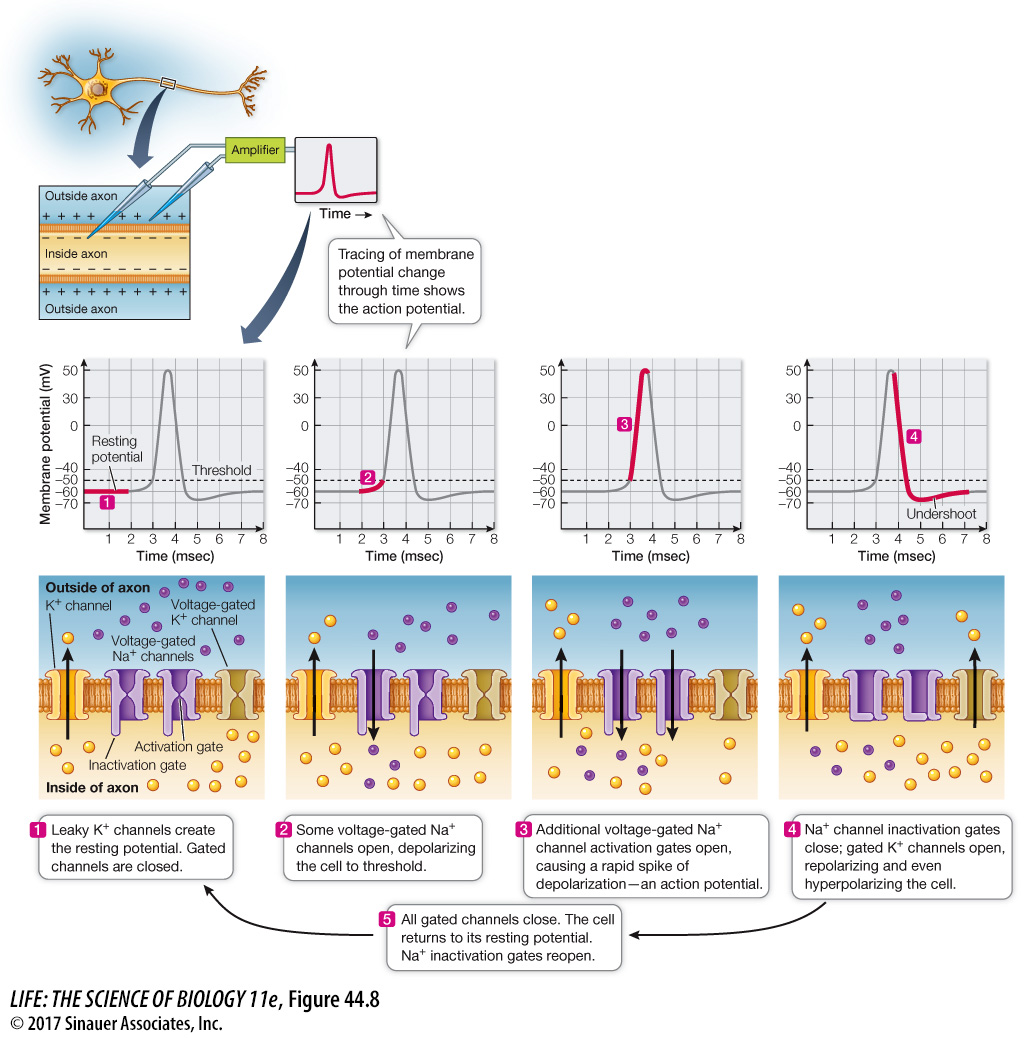Sudden changes in Na+ and K+ channels generate action potentials
APs are sudden, transient, large changes in membrane potential. In unmyelinated axons (those not wrapped in myelin by oligodendrocytes or Schwann cells), APs can be conducted at speeds of up to 2 meters per second, but in myelinated axons the conduction velocity can be 100 meters per second. Think of running the 100-meter dash—the world record is slightly under 10 seconds.
Page 946
If we place the tips of a pair of electrodes on either side of the cell membrane of a resting axon and measure the voltage difference, the reading might be about –60 mV, as you saw in Figure 44.4. If these electrodes are in place when an AP travels down the axon, they register a rapid change in membrane potential, from –60 mV to about +50 mV. The membrane potential then rapidly returns to its resting level of –60 mV (Figure 44.8).

Figure 44.8 The Course of an Action Potential Action potentials result from rapid changes in voltage-gated Na+ and K+ channels.
Animation 44.2 The Action Potential
The AP is generated by the openings and closings of voltage-gated Na+ and K+ channels in the cell membrane of the axon. At the resting potential, most of these channels are closed except for the leak K+ channels (balloon 1 in Figure 44.8). A slight depolarization of the membrane can cause some voltage-gated Na+ channels to open. Specifically, if a neuron is stimulated sufficiently to cause the membrane of its cell body to depolarize slightly, that graded potential spreads by local current flow to the axon hillock, the region of the cell body at the base of the axon (see Figure 44.1). Voltage-gated Na+ channels are concentrated in the axon hillock. A slight depolarization of the cell membrane in this area causes some of these voltage-gated channels to open briefly—for less than a millisecond (balloon 2 in Figure 44.8). When these channels open, the increased Na+ permeability depolarizes the membrane even more, causing more Na+ channels to open—a positive feedback effect. When the membrane is depolarized about 5–10 mV above the resting potential, a threshold is reached; a large number of sodium channels open (balloon 3 in Figure 44.8), and the membrane potential becomes positive—an AP. The rising phase of the AP halts abruptly in 1–2 milliseconds, and the membrane potential rapidly becomes negative once again.
What causes the axon to return to resting potential? There are two contributing factors: the voltage-gated Na+ channels close, and voltage-gated K+ channels open (balloon 4 in Figure 44.8). Voltage-gated K+ channels open in response to the same depolarization that triggered the Na+ channels, but they do so more slowly and they stay open longer, allowing K+ to carry excess positive charges out of the axon. As a result, the membrane potential returns to a negative value and usually becomes even more negative than the resting potential until the voltage-gated K+ channels close (balloon 5 in Figure 44.8).
Another feature of the voltage-gated Na+ channels is that once they open and close, they have a refractory period of 1–2 milliseconds during which they cannot open again. This property can be explained by the channels having two gates, an activation gate and an inactivation gate (see Figure 44.8). Under resting conditions, the activation gate is closed and the inactivation gate is open. Depolarization of the membrane to the threshold level causes both gates to change state, but the activation gate responds faster. As a result, the channel is open for a brief time between the opening of the activation gate and the closing of the inactivation gate. Inactivation gates remain closed for 1–2 milliseconds before they spontaneously open again, thus explaining the refractory period. By the time the inactivation gate reopens, the activation gate is closed, and the membrane is poised to generate another AP. Another contribution to the refractory period is the duration of the opening of the voltage-gated K+ channels, as you saw above. The dip in the membrane potential following an AP is called the after-hyperpolarization or undershoot.
Page 947
The difference in the concentration of Na+ across the cell membrane and the negative resting potential constitute the “battery” that drives APs. How rapidly does the battery run down? It might seem that a substantial number of ions would have to cross the membrane for the membrane potential to change from –60 mV to +50 mV and back to –60 mV again. In fact, only a vanishingly small number of Na+ ions move through the channels during the passage of an active potential. Thus, the effect of a single action potential on the concentration gradients of Na+ and K+ is very small, and the sodium–potassium pump can keep the “battery” charged, even when the neuron is generating many APs every second.
